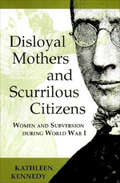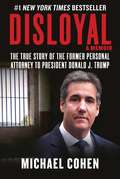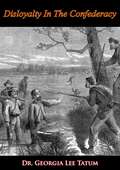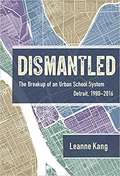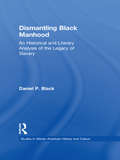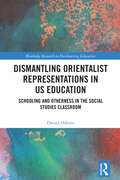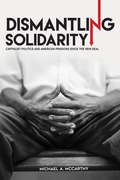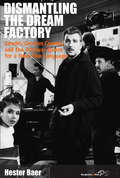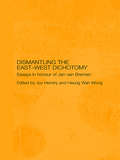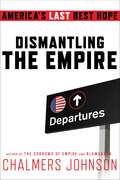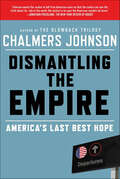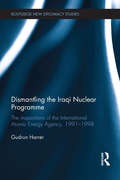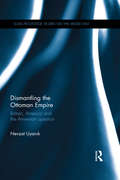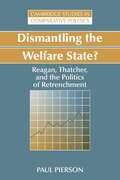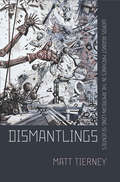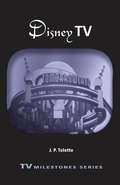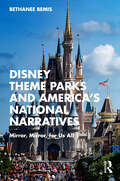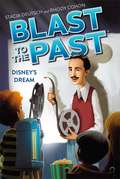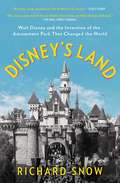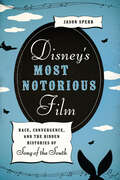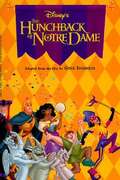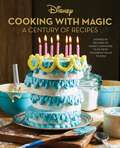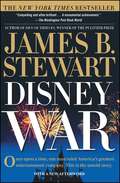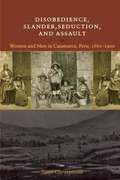- Table View
- List View
Disloyal Mothers and Scurrilous Citizens: Women and Subversion during World War I
by Kathleen KennedyA concise and highly readable study of women&’s influence on a crucial era in American political and cultural history. Kathleen Kennedy&’s unique study explores the arrests, trials, and defenses of women charged under the Wartime Emergency Laws passed soon after the US entered World War I. These women, often members of the political left, whose anti-war or pro-labor activity brought them to the attention of federal officials, made up ten percent of the approximately two thousand Federal Espionage cases. Their trials became important arenas in which women&’s relationships and obligations to national security were contested and defined. Anti-radical politics raised questions about the state&’s role in defining motherhood and social reproduction. Kennedy shows that state authorities often defined women&’s subversion as a violation of their maternal roles. Yet, with the exception of Kate Richards O&’Hare, the women charged with sedition did not define their political behavior within the terms set by maternalism. Instead, they used liberal arguments of equality, justice, and democratic citizenship to argue for their right to speak frankly about American policy. Such claims, while often in opposition to strategies outlined by their defense teams, helped form the framework for modern arguments made in defense of civil liberties.
Disloyal: The True Story of the Former Personal Attorney to President Donald J. Trump
by Michael CohenOnce Donald Trump’s fiercest surrogate, closest confidant, and staunchest defender, Michael Cohen knows where the skeletons are buried. <p><p> This is the most devastating business and political horror story of the century. As Trump’s lawyer and “fixer,” Cohen not only witnessed firsthand but was also an active participant in the inner workings of Trump’s business empire, political campaign, and presidential administration. <p> This is a story that you have not read in newspapers, or on social media, or watched on television. These are accounts that only someone who worked for Trump around the clock for over a decade—not a few months or even a couple of years—could know. Cohen describes Trump’s racist rants against President Barack Obama, Nelson Mandela, and Black and Hispanic people in general, as well as the cruelty, humiliation, and abuse he leveled at family and staff. Whether he’s exposing the fact that Trump engaged in tax fraud by inflating his wealth or electronic fraud by rigging an online survey, or outing Trump’s Neanderthal views towards women or his hush-money payments to clandestine lovers, Cohen pulls no punches. <p> He shows Trump’s relentless willingness to lie, exaggerate, mislead, or manipulate. Trump emerges as a man without a soul—a man who courts evangelicals and then trashes them, panders to the common man, but then rips off small business owners, a con man who will do or say absolutely anything to win, regardless of the cost to his family, his associates, or his country. <p> At the heart of Disloyal, we see how Cohen came under the spell of his charismatic "Boss" and, as a result, lost all sense of his moral compass. <p> The real "real" Donald Trump who permeates these pages—the racist, sexist, homophobic, lying, cheating President—will be discussed, written about, and analyzed for years to come.<p> <b>A New York Times Bestseller</b>
Disloyalty In The Confederacy
by Dr Georgia Lee Tatum"Until recently, many historians, as well as people in general, have commonly accepted the idea that every man, woman, and child in the South stood loyally behind Jefferson Davis and the Stars and Bars in support of the Confederacy. Despite the fact that out of a population of about eight million whites, six hundred thousand offered their services to the Confederacy in 1861, and also the fact that the staunch, unswerving loyalty of Southerners during the war will continue to rouse admiration, there was, in 1861, a small number, which by 1865 had increased to a potent minority, that did nothing to aid the Confederacy and much to injure it. While many showed their disaffection only by refusing to fight, many others organized not only for self-protection but also for the destruction of the Confederacy. Before the end of the war, there was much disaffection in every state, and many of the disloyal had formed into bands--in some states into well organized, active societies, with signs, oaths, grips, and passwords. In the present study, an attempt has been made to discover the causes for this movement, the classes that participated in it, and the purpose and work of the organizations."Disloyalty in the Confederacy definitely puts to rout the belief, once common, that 'every man, woman and child stood behind Jefferson Davis and the Stars and Bars in support of the Confederacy.' --New York Times Book Review"This is the sort of book necessary to balance accounts of the Southern Confederacy. Heretofore, the impression has been too often left that the South fought as a unit with a common purpose."--Journal of Southern History
Dismantled: The Breakup Of An Urban School System: Detroit, 1980-2016
by Leanne KangDismantled is an accessible, critical look at the devolution of local power in the Detroit public school system. The author examines the rise of charter schools and other private enterprises, the eclipse of control from local actors to new players and influences, and the invaluable lessons the experience holds for urban school systems nationwide. Kang provides a compelling narrative of this shift in power beginning in the 1980s and leading to the breakup of Detroit Public Schools in 2016, and concludes with a discussion on the implications and dilemmas of regime change. The text looks at such questions as: What happens when local actors no longer have a voice in what happens to their schools? What are the consequences when teachers and administrators cede control to private interests and cease to participate in decisionmaking? What are some ways to redirect public schooling toward democracy in the aftermath of dismantling the Progressive Era system?
Dismantling Black Manhood: An Historical and Literary Analysis of the Legacy of Slavery (Studies In African American History And Culture Ser.)
by Daniel P. BlackFirst published in 1997. Routledge is an imprint of Taylor & Francis, an informa company.
Dismantling Orientalist Representations in US Education: Schooling and Otherness in the Social Studies Classroom (Routledge Research in Decolonizing Education)
by Daniel OsbornThis book examines the evolving role played by the social studies classroom in shaping national identity and contributing to Orientalism, which depicts the peoples of the Middle East as “the Other” relative to those of the United States and Europe.Building upon the momentum of critical approaches to examining the nature of knowledge, the role of schools in society, and the trends within social studies education and its hidden curriculum, the volume crucially shifts the focus toward a more global emphasis, examining the nature of Orientalism and the school as a setting where Orientalist logic and assumptions about the Middle East and its inhabitants are reified. Focusing on the ecosystem of social studies knowledge production and working within the sociology of knowledge, it traces this evolution across the 19th, 20th, and 21st centuries.A novel and unique exploration of knowledge construction, and presenting a vision for a more nuanced and multifaceted portrayal of the Middle East that corrects for the deleterious aspects of Orientalism while avoiding a romanticized apologetic, it will appeal to scholars, researchers, and educators with interests in decolonizing education, social studies education, the history of education, and race and ethnicity studies.
Dismantling Solidarity: Capitalist Politics and American Pensions since the New Deal
by Michael A. MccarthyWhy has old-age security become less solidaristic and increasingly tied to risky capitalist markets? Drawing on rich archival data that covers more than fifty years of American history, Michael A. McCarthy argues that the critical driver was policymakers' reactions to capitalist crises and their political imperative to promote capitalist growth. Pension development has followed three paths of marketization in America since the New Deal, each distinct but converging: occupational pension plans were adopted as an alternative to real increases in Social Security benefits after World War II, private pension assets were then financialized and invested into the stock market, and, since the 1970s, traditional pension plans have come to be replaced with riskier 401(k) retirement plans. Comparing each episode of change, Dismantling Solidarity mounts a forceful challenge to common understandings of America’s private pension system and offers an alternative political economy of the welfare state. McCarthy weaves together a theoretical framework that helps to explain pension marketization with structural mechanisms that push policymakers to intervene to promote capitalist growth and avoid capitalist crises and contingent historical factors that both drive them to intervene in the particular ways they do and shape how their interventions bear on welfare change. By emphasizing the capitalist context in which policymaking occurs, McCarthy turns our attention to the structural factors that drive policy change. Dismantling Solidarity is both theoretically and historically detailed and superbly argued, urging the reader to reconsider how capitalism itself constrains policymaking. It will be of interest to sociologists, political scientists, historians, and those curious about the relationship between capitalism and democracy. 0
Dismantling The Dream Factory
by Hester BaerThe history of postwar German cinema has most often been told as a story of failure, a failure paradoxically epitomized by the remarkable popularity of film throughout the late 1940s and 1950s. Through the analysis of 10 representative films, Hester Baer reassesses this period, looking in particular at how the attempt to 'dismantle the dream factory' of Nazi entertainment cinema resulted in a new cinematic language which developed as a result of the changing audience demographic. In an era when female viewers comprised 70 per cent of cinema audiences a 'women's cinema' emerged, which sought to appeal to female spectators through its genres, star choices, stories and formal conventions. In addition to analyzing the formal language and narrative content of these films, Baer uses a wide array of other sources to reconstruct the original context of their reception, including promotional and publicity materials, film programs, censorship documents, reviews and spreads in fan magazines. This book presents a new take on an essential period, which saw the rebirth of German cinema after its thorough delegitimization under the Nazi regime.
Dismantling the East-West Dichotomy: Essays in Honour of Jan van Bremen (Japan Anthropology Workshop Series)
by Joy HendryIt has been customary in the appraisal of the different approaches to the study of Japan anthropology to invoke an East-West dichotomy positing hegemonic ‘Western’ systems of thought against a more authentic ‘Eastern’ alternative. Top scholars in the field of Japan anthropology examine, challenge and attempt to move beyond the notion of an East-West divide in the study of Japan anthropology. They discuss specific fieldwork and ethnographic issues, the place of the person within the context of the dichotomy, and regional perspectives on the issue. Articulating the influence of the East-West divide in other disciplines, including museum studies, religion, business and social ecology, the book attempts to look towards a new anthropology that transcends the limitations of a simplistic East-West opposition, taking into account the wealth of regional and global perspectives that are exhibited by contemporary scholarship on Japan anthropology. In concluding if the progress achieved in anthropological work on Japan can provide a model for good practice beyond this regional specialization, this timely and important book provides a valuable examination of the current state of the academic study of Japan anthropology.
Dismantling the Empire: America's Last Best Hope
by Chalmers JohnsonThe author of the bestselling Blowback Trilogy reflects on America's waning power in a masterful collection of essays. In his prophetic book Blowback, published before 9/11, Chalmers Johnson warned that our secret operations in Iraq and elsewhere around the globe would exact a price at home. Now, in a brilliant series of essays written over the last three years, Johnson measures that price and the resulting dangers America faces. Our reliance on Pentagon economics, a global empire of bases, and war without end is, he declares, nothing short of "a suicide option." Dismantling the Empire explores the subjects for which Johnson is now famous, from the origins of blowback to Barack Obama's Afghanistan conundrum, including our inept spies, our bad behavior in other countries, our ill-fought wars, and our capitulation to a military that has taken ever more control of the federal budget. There is, he proposes, only one way out: President Obama must begin to dismantle the empire before the Pentagon dismantles the American Dream. If we do not learn from the fates of past empires, he suggests, our decline and fall are foreordained. This is Johnson at his best: delivering both a warning and an urgent prescription for a remedy.
Dismantling the Empire: America's Last Best Hope (The American Empire Project)
by Chalmers JohnsonThe author of the bestselling Blowback Trilogy reflects on America's waning power in a masterful collection of essays In his prophetic book Blowback, published before 9/11, Chalmers Johnson warned that our secret operations in Iraq and elsewhere around the globe would exact a price at home. Now, in a brilliant series of essays written over the last three years, Johnson measures that price and the resulting dangers America faces. Our reliance on Pentagon economics, a global empire of bases, and war without end is, he declares, nothing short of "a suicide option." Dismantling the Empire explores the subjects for which Johnson is now famous, from the origins of blowback to Barack Obama's Afghanistan conundrum, including our inept spies, our bad behavior in other countries, our ill-fought wars, and our capitulation to a military that has taken ever more control of the federal budget. There is, he proposes, only one way out: President Obama must begin to dismantle the empire before the Pentagon dismantles the American Dream. If we do not learn from the fates of past empires, he suggests, our decline and fall are foreordained. This is Johnson at his best: delivering both a warning and an urgent prescription for a remedy.
Dismantling the Iraqi Nuclear Programme: The Inspections of the International Atomic Energy Agency, 1991–1998 (Routledge New Diplomacy Studies)
by Gudrun HarrerThis book is an authoritative account of the nuclear weapons inspections regime in Iraq from 1991 to 1998. Without a proper understanding of those years, the 2003 US invasion of Iraq after a futile WMD search remain unintelligible. In the 1990s, after adapting to a completely new kind of intrusive inspections with unprecedented access rights, the IAEA discovered and dismantled Iraq’s clandestine nuclear weapons program and put in place an efficient monitoring system which could have contained Saddam Hussein’s attempts to reconstitute his nuclear programs – had he ever tried to. However, the politicisation of the inspection process led to an end of the inspections in 1998. Based on various sources including inspection reports and other documents in the archive of the IAEA Iraq Action Team at the IAEA headquarters in Vienna, Dismantling the Iraqi Nuclear Programme presents completely new information about the weapons inspection regime in Iraq and offers valuable lessons for future non-proliferation and disarmament cases. The book also draws on discourse from Iraqi scientists, which provides a close look into not only the motivation of involved Iraqis, but also Iraqi concealment mechanisms. This book will be of much interest to students of nuclear proliferation, arms control, Middle Eastern politics, diplomacy, international security and IR.
Dismantling the Ottoman Empire: Britain, America and the Armenian question (SOAS/Routledge Studies on the Middle East)
by Nevzat UyanıkPrior to World War I, American involvement in Armenian affairs was limited to missionary and educational interests. This was contrary to Britain, which had played a key role in the diplomatic arena since the Treaty of Berlin in 1878, when the Armenian question had become a subject of great power diplomacy. However, by the end of the war the dynamics of the international system had undergone drastic change, with America emerging as one of the primary powers politically involved in the Armenian issue. Dismantling the Ottoman Empire explores this evolution of the United States’ role in the Near East, from politically distant and isolated power to assertive major player. Through careful analysis of the interaction of Anglo-American policies vis-à-vis the Ottoman Armenians, from the Great War through the Lausanne Peace Conference, it examines the change in British and American strategies towards the region in light of the tension between the notions of new diplomacy vs. old diplomacy. The book also highlights the conflict between humanitarianism and geostrategic interests, which was a particularly striking aspect of the Armenian question during the war and post war period. Using material drawn from public and personal archives and collections, it sheds light on the geopolitical dynamics and intricacies of great power politics with their long-lasting effects on the reshuffling of the Middle East. The book would be of interest to scholars and students of political & diplomatic history, Near Eastern affairs, American and British diplomacy in the beginning of the twentieth century, the history of the Ottoman Empire, the Middle East and the Caucasus.
Dismantling the Welfare State? Reagan, Thatcher and the Politics of Retrenchment
by Paul PiersonFocusing on the administrations of Ronald Reagan and Margaret Thatcher, Pierson provides a compelling explanation for the welfare state's durability and for the few occasions in which each government was able to achieve significant cutbacks.
Dismantlings: Words against Machines in the American Long Seventies
by Matt Tierney"For the master's tools," the poet Audre Lorde wrote, "will never dismantle the master's house." Dismantlings is a study of literary, political, and philosophical critiques of the utopian claims about technology in the Long Seventies, the decade and a half before 1980. Following Alice Hilton's 1963 admonition that the coming years would bring humanity to a crossroads—"machines for HUMAN BEINGS or human beings for THE MACHINE"—Matt Tierney explores wide-ranging ideas from science fiction, avant-garde literatures, feminist and anti-racist activism, and indigenous eco-philosophy that may yet challenge machines of war, control, and oppression.Dismantlings opposes the language of technological idealism with radical thought of the Long Seventies, from Lorde and Hilton to Samuel R. Delany and Ursula K. Le Guin to Huey P. Newton, John Mohawk, and many others. This counter-lexicon retrieves seven terms for the contemporary critique of technology: Luddism, a verbal and material combat against exploitative machines; communion, a kind of togetherness that stands apart from communication networks; cyberculture, a historical conjunction of automation with racist and militarist machines; distortion, a transformative mode of reading and writing; revolutionary suicide, a willful submission to the risk of political engagement; liberation technology, a synthesis of appropriate technology and liberation theology; and thanatopography, a mapping of planetary technological ethics after Auschwitz and Hiroshima. Dismantlings restores revolutionary language of the radical Long Seventies for reuse in the digital present against emergent technologies of exploitation, subjugation, and death.
Disney TV: Disney Tv (Tv Milestones Ser.)
by J. P. TelotteA historical account of the context, impact, and legacy of one of the most successful series in American television history.
Disney Theatrical Productions: Producing Broadway Musicals the Disney Way
by Amy S. OsatinskiDisney Theatrical Productions: Producing Broadway Musicals the Disney Way is the first work of scholarship to comprehensively examine the history and production practices of Disney Theatrical Productions (DTP), the theatrical producing arm of the studio branch of the Walt Disney Corporation. This book uncovers how DTP has forged a new model for producing large-scale musicals on Broadway by functioning as an independent theatrical producer under the umbrella of a large entertainment corporation. Case studies of three productions (The Lion King, Tarzan, and Newsies) demonstrate the flexibility and ingenuity of DTP, and showcase the various production models that the company has employed over the years. Exploring topics such as the history of DTP, its impact on the revitalization of Times Square, and its ability to open up a new audience base for Broadway theatre, this volume examines the impact that DTP has had on American musicals, both domestically and internationally, and how its accomplishments have helped reshape the Broadway landscape. This book is relevant to students in Musical Theatre, History of Musical Theatre, Theatre History, and Arts Management courses, along with general Disney enthusiasts.
Disney Theme Parks and America’s National Narratives: Mirror, Mirror, for Us All
by Bethanee BemisDisney Theme Parks and America’s National Narratives takes a public history approach to situating the physical spaces of the Disney brand within memory and identity studies. For over 65 years, Disney’s theme parks have been important locations for the formation and negotiation of the collective memory of the American narrative. Disney’s success as one of America’s most prolific storytellers, its rise as a symbol of America itself, and its creation of theme parks that immerse visitors in three-dimensional versions of certain "American" values and historic myths have both echoed and shaped the way the American people see themselves. Like all versions of the American narrative, Disney’s vision serves to reassure us, affirm our shared values, and unite a diverse group of people under a distinctly American identity—or at least, it did. The book shows how the status Disney obtained led the public to use them both as touchstones of identity and as spaces to influence the American identity writ large. This volume also examines the following: • how Disney’s original cartoons and live-action entertainment offerings drew from American folk history and ideals • how their work during World War II cemented them as an American symbol at home and abroad • how the materialization of the American themes already espoused by the brand at their theme parks created a place where collective memory lives • how legitimization by presidents and other national figures gave the theme parks standing no other entertainment space has • how Disney has changed alongside the American people and continues to do so today. This book will be of interest to students and scholars of history, media, cultural studies, American studies and tourism.
Disney's Dream (Blast to the Past #2)
by Stacia Deutsch Rhody Cohon David WenzelThe kids in Mr. Caruthers's class don't want a world without cartoons. Can they persuade Walt Disney to pursue his passion? Book two in an action-packed time-travel series. "What if Walt Disney quit and never made "Steamboat Willie"?" That's the question Mr. Caruthers poses to his third grade class on Monday morning. Abigail, Jacob, Zack, and Bo are excited to travel back in time and meet Walt Disney, and they're determined to convince Mr. Disney not give up making the first animated movie with sound. After all, what would their world be like without modern cartoons? Not to mention no Mickey Mouse, no Disneyland, and no Disney Channel But will the kids be able to help Mr. Disney follow his dream before time runs out?
Disney's Land: Walt Disney and the Invention of the Amusement Park That Changed the World
by Richard SnowA propulsive history chronicling the conception and creation of Disneyland, the masterpiece California theme park, as told like never before by popular historian Richard Snow.One day in the early 1950s, Walt Disney stood looking over 240 acres of farmland in Anaheim, California, and imagined building a park where people &“could live among Mickey Mouse and Snow White in a world still powered by steam and fire for a day or a week or (if the visitor is slightly mad) forever.&” Despite his wealth and fame, exactly no one wanted Disney to build such a park. Not his brother Roy, who ran the company&’s finances; not the bankers; and not his wife, Lillian. Amusement parks at that time, such as Coney Island, were a generally despised business, sagging and sordid remnants of bygone days. Disney was told that he would only be heading toward financial ruin. But Walt persevered, initially financing the park against his own life insurance policy and later with sponsorship from ABC and the sale of thousands and thousands of Davy Crockett coonskin caps. Disney assembled a talented team of engineers, architects, artists, animators, landscapers, and even a retired admiral to transform his ideas into a soaring yet soothing wonderland of a park. The catch was that they had only a year and a day in which to build it. On July 17, 1955, Disneyland opened its gates…and the first day was a disaster. Disney was nearly suicidal with grief that he had failed on a grand scale. But the curious masses kept coming, and the rest is entertainment history. Eight hundred million visitors have flocked to the park since then. In Disney&’s Land, Richard Snow brilliantly presents the entire spectacular story, a wild ride from vision to realization, and an epic of innovation and error that reflects the uniqueness of the man determined to build &“the happiest place on earth&” with a watchmaker&’s precision, an artist&’s conviction, and the desperate, high-hearted recklessness of a riverboat gambler.
Disney's Most Notorious Film: Race, Convergence, and the Hidden Histories of Song of the South
by Jason SperbThe Walt Disney Company offers a vast universe of movies, television shows, theme parks, and merchandise, all carefully crafted to present an image of wholesome family entertainment. Yet Disney also produced one of the most infamous Hollywood films, Song of the South. Using cartoon characters and live actors to retell the stories of Joel Chandler Harris, SotS portrays a kindly black Uncle Remus who tells tales of Brer Rabbit, Brer Fox, and the “Tar Baby” to adoring white children. Audiences and critics alike found its depiction of African Americans condescending and outdated when the film opened in 1946, but it grew in popularity—and controversy—with subsequent releases. Although Disney has withheld the film from American audiences since the late 1980s, SotS has an enthusiastic fan following, and pieces of the film—such as the Oscar-winning “Zip-a-Dee-Doo-Dah”—remain throughout Disney’s media universe. Disney’s Most Notorious Film examines the racial and convergence histories of Song of the South to offer new insights into how audiences and Disney have negotiated the film’s controversies over the last seven decades. Jason Sperb skillfully traces the film’s reception history, showing how audience perceptions of SotS have reflected debates over race in the larger society. He also explores why and how Disney, while embargoing the film as a whole, has repurposed and repackaged elements of SotS so extensively that they linger throughout American culture, serving as everything from cultural metaphors to consumer products.
Disney's The Hunchback of Notre Dame (Junior Novelization)
by Gina IngogliaSet in the picturesque Parisian streets of the fifteenth century, this adventure centers on Quasimodo, the gentle and lonely hunchbacked bell-ringer confined to the tower of the Notre Dame cathedral. Quasimodo finds a friend in the gypsy Esmeralda.
Disney: Inspired by Decades of Disney's Animated Films from Steamboat Willie to Wish
by Lisa Kingsley Brooke Vitale Jennifer PetersonCelebrate your love of classic Disney animated films and make your kitchen magical with this comprehensive cookbook, inspired by beloved Disney films from 1937 to now, including Fantasia, Mulan, and more!Experience delicious dishes inspired by your favorite Disney animated films from 1937 to now with Disney: Cooking With Magic: A Century of Recipes! Featuring Disney&’s classic films like Snow White and the Seven Dwarfs and Encanto, fans will delight in the enchanting, easy-to-prepare recipes in this cookbook, from magical main courses to delectable desserts. Featuring beautiful full-color photography, helpful cooking tips, and recipes ranging from simple to advanced, this cookbook is perfect for home cooks of all skill levels. Filled with delicious recipes inspired by beloved Disney films over the decades, this cookbook is a must-have for adult Disney fans and is the perfect way to bring friends and family together with a little Disney magic. BRING THE WORLD OF DISNEY INTO YOUR KITCHEN: Relive iconic mealtime moments from Disney films with food inspired by scenes from The Aristocats, Treasure Planet, and more 80+ RECIPES: With over 80 recipes inspired by classic Disney animated films, there&’s something to delight everyone FOR ALL SKILL LEVELS: Perfect for adult home cooks of all skill levels, this book has easy-to-follow recipes and everyday ingredients, making it perfect for every occasion INSPIRING IMAGES: Full-color photos of completed dishes help ensure success! DISHES FROM AROUND THE WORLD: Discover Disney recipes from all over the globe with dishes from Europe, the Middle East, and more! GREAT GIFT IDEA: Perfect for every occasion, Disney fans will adore this deluxe cookbook ADD TO YOUR DISNEY COLLECTION: Pair the recipes in Disney: Cooking With Magic: A Century of Recipes with dishes from Insight Editions&’ charming line of Disney cookbooks, including Disney Enchanted Recipes Cookbook, Disney Villains: Devilishly Delicious Cookbook, and Disney Princess: Healthy Treats Cookbook
DisneyWar: The Battle for the Magic Kingdom
by James B. Stewart"When You Wish Upon a Star," "Whistle While You Work," "The Happiest Place on Earth" -- these are lyrics indelibly linked to Disney, one of the most admired and best-known companies in the world. So when Roy Disney, chairman of Walt Disney Animation and nephew of founder Walt Disney, abruptly resigned in November 2003 and declared war on chairman and chief executive Michael Eisner, he sent shock waves through the entertainment industry, corporate boardrooms, theme parks, and living rooms around the world -- everywhere Disney does business and its products are cherished. DisneyWar is the breathtaking, dramatic inside story of what drove America's best-known entertainment company to civil war, told by one of our most acclaimed writers and reporters. Drawing on unprecedented access to both Eisner and Roy Disney, current and former Disney executives and board members, as well as thousands of pages of never-before-seen letters, memos, transcripts, and other documents, James B. Stewart gets to the bottom of mysteries that have enveloped Disney for years: What really caused the rupture with studio chairman Jeffrey Katzenberg, a man who once regarded Eisner as a father but who became his fiercest rival? How could Eisner have so misjudged Michael Ovitz, a man who was not only "the most powerful man in Hollywood" but also his friend, whom he appointed as Disney president and immediately wanted to fire? What caused the break between Eisner and Pixar chairman Steve Jobs, and why did Pixar abruptly abandon its partnership with Disney? Why did Eisner so mistrust Roy Disney that he assigned Disney company executives to spy on him? How did Eisner control the Disney board for so long, and what really happened in the fateful board meeting in September 2004, when Eisner played his last cards? Here, too, is the creative process that lies at the heart of Disney -- from the making of The Lion King to Pirates of the Caribbean. Even as the executive suite has been engulfed in turmoil, Disney has worked -- and sometimes clashed -- with a glittering array of stars, directors, designers, artists, and producers, many of whom tell their stories here for the first time. Stewart describes how Eisner lost his chairmanship and why he felt obliged to resign as CEO, effective 2006. No other book so thoroughly penetrates the secretive world of the corporate boardroom. DisneyWar is an enthralling tale of one of America's most powerful media and entertainment companies, the people who control it, and those trying to overthrow them. DisneyWar is an epic achievement. It tells a story that -- in its sudden twists, vivid, larger-than-life characters, and thrilling climax -- might itself have been the subject of a Disney animated classic -- except that it's all true.
Disobedience, Slander, Seduction, and Assault: Women and Men in Cajamarca, Peru, 1862-1900
by Tanja ChristiansenThough the law and courts of nineteenth-century Peru were institutions created by and for the ruling elite, women of all classes used the system to negotiate the complexities of property rights, childrearing, and marriage, and often to defend their very definitions of honor. Drawing on the trial transcripts of Cajamarca, a northern Peruvian province, from more than a century ago, this book shares eye-opening details about life among this community, in which reputation could determine a woman's chances of survival.
